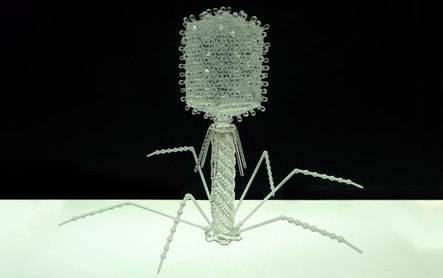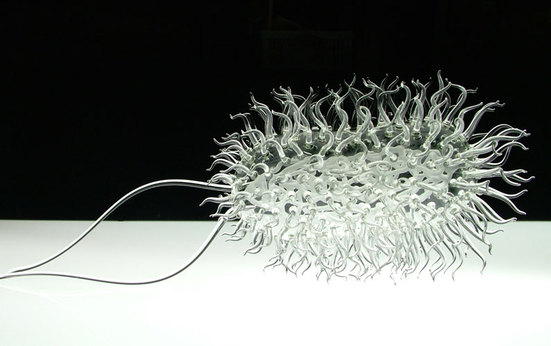|
by Sophia Park '13.5 Any visitor to Luke Jerram’s glass microbiology exhibition would be pleasantly surprised to see lethal pathogens sculpted in delicate glassworks that are unsettlingly fragile and transparent. His work is the first attempt to provide a detailed three-dimensional representation of microbiology in glass, and the Scientific American boasts, “You’ve never really seen a virus until you see this.” (1) First developed in 2004, Jerram’s glass viruses have traveled to critical acclaim and commercial success in more than 10 cities including New York, London, Madrid, Shanghai, Seoul, Tokyo and Tel Aviv. Jerram aimed to represent viruses in their natural colorless states. “Early on in my research I discovered that viruses have no color as they are smaller than the wavelength of light,” said Jerram. “Because I’m colorblind, I’m interested in how we see the world and in exploring the edges of perception.” (1) 
The T4 bacteriophage infects E. coli bacteria and carries its DNA in its large head. [image via]
The scientific community regarded Jerram’s glassworks favorably. Applauded for their delicacy if not accuracy, the pieces serve as great representations for both internal and external structures of viruses. Indeed, the artist had frequently communicated with virologists in order to catch up with the most current understanding of viral structures and their chemical models. However, spikes, receptors, and cilia covering the exterior surface of the glass pathogens are decoratively beautiful but exaggerated in scale. In an interview with the New York Times (2), Jerram explains that these inaccuracies make the structure less fragile. While his initial aim was to complement current illustrations biased by color, his sculptures with larger spikes could also be considered partial. 
Bird flu (H5N1) spreads slowly and is often fatal. [image via]
Regardless, Jerram’s efforts carry artistic significance in their approach. Some say Jerram’s aesthetic approach to address death connects to other modern British artists (2), namely Damien Hirst, who is known for using dissected animals in art.
Throughout his career as an artist, Jerram has been exploring how we perceive the world and has sought to place himself at the intersection of science and art. From Plant Orchestra to Retinal Memory Volume, his artistic imagination seeks to explore biological processes and artistically recreate them. More of his work can be viewed on his website.
0 Comments
Leave a Reply. |

